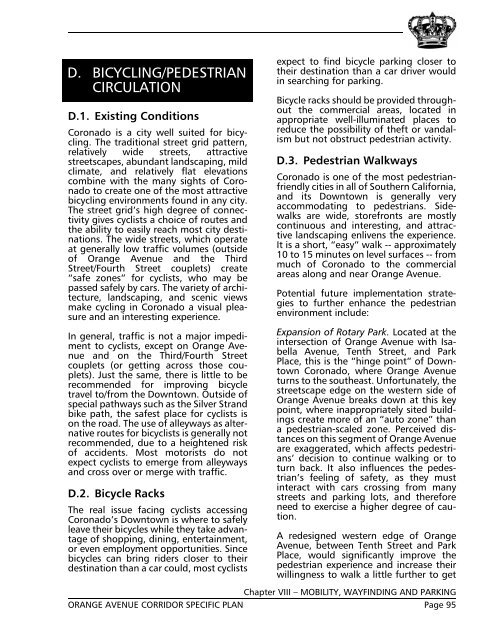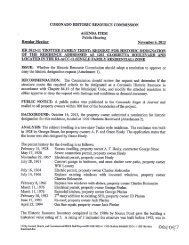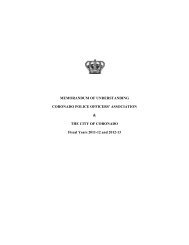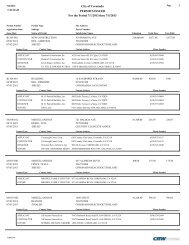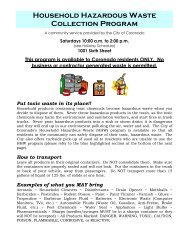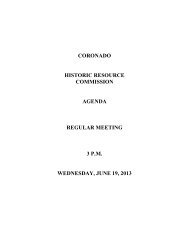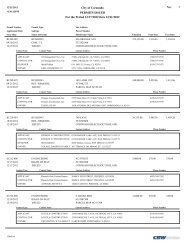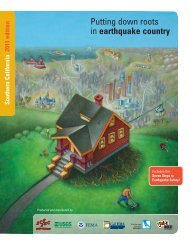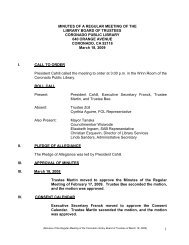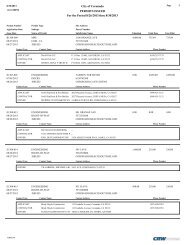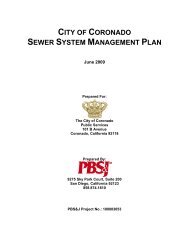The Orange Avenue Corridor Specific Plan - City of Coronado
The Orange Avenue Corridor Specific Plan - City of Coronado
The Orange Avenue Corridor Specific Plan - City of Coronado
Create successful ePaper yourself
Turn your PDF publications into a flip-book with our unique Google optimized e-Paper software.
D. BICYCLING/PEDESTRIAN<br />
CIRCULATION<br />
D.1. Existing Conditions<br />
<strong>Coronado</strong> is a city well suited for bicycling.<br />
<strong>The</strong> traditional street grid pattern,<br />
relatively wide streets, attractive<br />
streetscapes, abundant landscaping, mild<br />
climate, and relatively flat elevations<br />
combine with the many sights <strong>of</strong> <strong>Coronado</strong><br />
to create one <strong>of</strong> the most attractive<br />
bicycling environments found in any city.<br />
<strong>The</strong> street grid’s high degree <strong>of</strong> connectivity<br />
gives cyclists a choice <strong>of</strong> routes and<br />
the ability to easily reach most city destinations.<br />
<strong>The</strong> wide streets, which operate<br />
at generally low traffic volumes (outside<br />
<strong>of</strong> <strong>Orange</strong> <strong>Avenue</strong> and the Third<br />
Street/Fourth Street couplets) create<br />
“safe zones” for cyclists, who may be<br />
passed safely by cars. <strong>The</strong> variety <strong>of</strong> architecture,<br />
landscaping, and scenic views<br />
make cycling in <strong>Coronado</strong> a visual pleasure<br />
and an interesting experience.<br />
In general, traffic is not a major impediment<br />
to cyclists, except on <strong>Orange</strong> <strong>Avenue</strong><br />
and on the Third/Fourth Street<br />
couplets (or getting across those couplets).<br />
Just the same, there is little to be<br />
recommended for improving bicycle<br />
travel to/from the Downtown. Outside <strong>of</strong><br />
special pathways such as the Silver Strand<br />
bike path, the safest place for cyclists is<br />
on the road. <strong>The</strong> use <strong>of</strong> alleyways as alternative<br />
routes for bicyclists is generally not<br />
recommended, due to a heightened risk<br />
<strong>of</strong> accidents. Most motorists do not<br />
expect cyclists to emerge from alleyways<br />
and cross over or merge with traffic.<br />
D.2. Bicycle Racks<br />
<strong>The</strong> real issue facing cyclists accessing<br />
<strong>Coronado</strong>’s Downtown is where to safely<br />
leave their bicycles while they take advantage<br />
<strong>of</strong> shopping, dining, entertainment,<br />
or even employment opportunities. Since<br />
bicycles can bring riders closer to their<br />
destination than a car could, most cyclists<br />
expect to find bicycle parking closer to<br />
their destination than a car driver would<br />
in searching for parking.<br />
Bicycle racks should be provided throughout<br />
the commercial areas, located in<br />
appropriate well-illuminated places to<br />
reduce the possibility <strong>of</strong> theft or vandalism<br />
but not obstruct pedestrian activity.<br />
D.3. Pedestrian Walkways<br />
<strong>Coronado</strong> is one <strong>of</strong> the most pedestrianfriendly<br />
cities in all <strong>of</strong> Southern California,<br />
and its Downtown is generally very<br />
accommodating to pedestrians. Sidewalks<br />
are wide, storefronts are mostly<br />
continuous and interesting, and attractive<br />
landscaping enlivens the experience.<br />
It is a short, “easy” walk -- approximately<br />
10 to 15 minutes on level surfaces -- from<br />
much <strong>of</strong> <strong>Coronado</strong> to the commercial<br />
areas along and near <strong>Orange</strong> <strong>Avenue</strong>.<br />
Potential future implementation strategies<br />
to further enhance the pedestrian<br />
environment include:<br />
Expansion <strong>of</strong> Rotary Park. Located at the<br />
intersection <strong>of</strong> <strong>Orange</strong> <strong>Avenue</strong> with Isabella<br />
<strong>Avenue</strong>, Tenth Street, and Park<br />
Place, this is the “hinge point” <strong>of</strong> Downtown<br />
<strong>Coronado</strong>, where <strong>Orange</strong> <strong>Avenue</strong><br />
turns to the southeast. Unfortunately, the<br />
streetscape edge on the western side <strong>of</strong><br />
<strong>Orange</strong> <strong>Avenue</strong> breaks down at this key<br />
point, where inappropriately sited buildings<br />
create more <strong>of</strong> an “auto zone” than<br />
a pedestrian-scaled zone. Perceived distances<br />
on this segment <strong>of</strong> <strong>Orange</strong> <strong>Avenue</strong><br />
are exaggerated, which affects pedestrians’<br />
decision to continue walking or to<br />
turn back. It also influences the pedestrian’s<br />
feeling <strong>of</strong> safety, as they must<br />
interact with cars crossing from many<br />
streets and parking lots, and therefore<br />
need to exercise a higher degree <strong>of</strong> caution.<br />
A redesigned western edge <strong>of</strong> <strong>Orange</strong><br />
<strong>Avenue</strong>, between Tenth Street and Park<br />
Place, would significantly improve the<br />
pedestrian experience and increase their<br />
willingness to walk a little further to get<br />
Chapter VIII – MOBILITY, WAYFINDING AND PARKING<br />
ORANGE AVENUE CORRIDOR SPECIFIC PLAN Page 95


